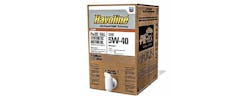Life is always changing in the fast lube market. The fastest change is in the space we need for new products. We started out years ago with bulk oil and plastic quart bottles. We then added 55-gallon drums. Our storage space is almost down to nothing. But new oils, transmission fluids and coolants are needed to meet the new OEM requirements. Luckily, there’s a new product on the market to help meet these needs — the Bag in a Box concept.
What is a Bag in a Box (BIB) concept? It is a cardboard box containing a six-gallon copolymer plastic bag with a dispensing spout and a rack that can hold several of these units. Why is this concept better than a 55-gallon drum and case oil (quarts)?
First, 55-gallon drums are heavy; they take up space and need a pump. The pump never gets all the fluid out of the drum. The estimated fluid left in a drum is about one to 1.5 gallons. (I will use oil as the fluid and will use $5 per gallon as a base figure). This is a loss to the business of between $5 to $7.50 per drum.
Let’s examine case oil next. Two cases of motor oil are 24-quart plastic bottles. This is six gallons of oil that take up 1.78 cubic feet of storage vs. 0.82 cubic feet of BIB. Each bottle uses about 51 grams of HDPE plastic, or 1,224 grams for 24 bottles vs 13 grams for the BIB.
All the plastic bottles must be drained. If they are not drained, 24 bottles will contain about 25.6 ounces of oil vs. 8 ounces for the BIB system — a loss to the business in oil of $1.02 vs $0.32 for the BIB. Plus, you have to consider the carbon footprint of HDPE in the landfill. Use of the BIB would save 89 percent of HDPE plastic going into the landfill. Draining the plastic oil bottles (a 24-hour drain) removes all but 2.5 ounces of the oil (saving of 23.1 ounces of oil per two cases).
Let’s discuss the BIB. What do you need, and why is it best to use them?
First: Consider the space needed to store them. It takes 0.82 cubic feet vs. 24 case bottles at 1.78 cubic feet.
Second: As discussed above, wasted oil/carbon footprint for 24 case bottles 1.78 cubic feet vs. 0.21 inches for BIB.
Third: You need a rack. Each rack will hold between 4-12 units of BIB.
Fourth: To drain the BIB, open the drain and tilt for 20 minutes. This removes 99 percent of the product from the BIB.
Fifth: Remove the empty BIB, remove the plastic liner from the cardboard box, recycle the box and follow state rules/regulations on the plastic liner.
Sixth: BIB is more efficient for end users. Inventory management — it’s safe; it’s easy to install, use and dispose of; and it requires less handling and offers fast dispensing.
One last thing that must be kept in mind is roughly how much oil/plastic is put in landfills each year. It is estimated that in oil alone, this amounts to 137,000,000 quarts or 34,250,000 gallons. Using the $5 per gallon figure, this amounts to $171,250,000 straight into the landfill. What a waste of oil and plastic!
Note: All the above oil/plastic figures came from a scientific study outside of the oil industry.
Technical Tips provided by Scotti Lee, Ph.D., former operator of Oil Change Express in New Castle, Delaware. Lee may be reached at 302.324.1900. Technical Tips is a forum for fast lube operators and suppliers to share practical solutions to problems common throughout the industry. National Oil & Lube News is not responsible for the accuracy or reliability of submitted tips, and NOLN does not assume liability resulting from their use. The author of each tip published will receive a free one year subscription or a free one-year extension to an existing U.S. subscription. E-mail tips to: [email protected]
